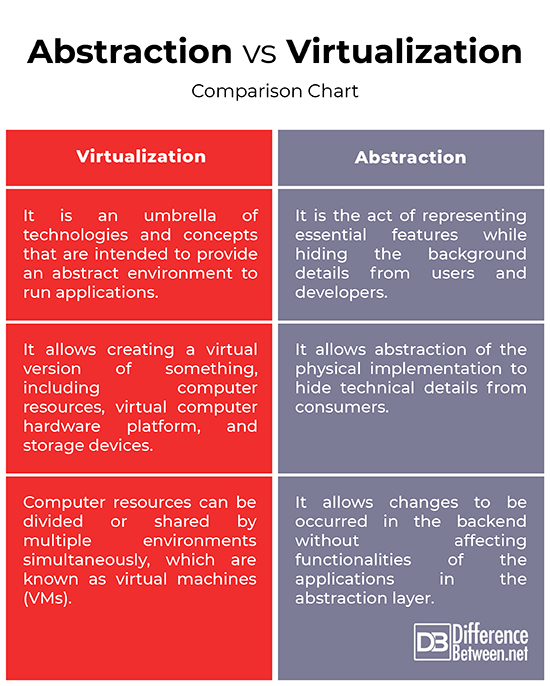Difference Between Abstraction and Virtualization
Abstraction vs. Virtualization
It is the ability of creating or grouping a resource pool that is what differentiates cloud computing from other types of networked systems. But not all cloud computing applications create resource pools that can be assigned to users on demand, but a significant number of cloud-based systems do. When using cloud computing, we are accessing pooled resources using a technique called virtualization, which allows creating a virtual version of computer resources with a goal of centralizing administrative tasks. Virtualization has become an indispensable tool for almost every cloud; it has become an important technique for establishing modern cloud computing services.
However, it is very likely to be confused with yet another overly used concept called abstraction. Virtualization is similar to abstraction but it does not always hide the low layer’s details. The concept of virtual machines is not new; in fact, virtual machines existed since the 1960s when IBM developed the first virtual machine to provide interactive access to a mainframe computer. Abstraction enables the key benefit of cloud computing, which is shared, ubiquitous access. Abstraction is the act of representing essential features while hiding the background details from users and developers. It is used to reduce cost and complexity, which in turn, simplifies operations.
What is Virtualization?
Virtualization is a technology that allows creating a virtual version (rather than actual) of something, including computer resources, virtual computer hardware platform, operating system, and storage devices. It allows computer resources to be divided or shared by multiple environments simultaneously with the intention of centralizing administrative tasks while improving scalability and workloads. These environments are commonly known as virtual machines (VMs). Virtualization is not a new concept; in fact, the concept of virtual machines existed since the 1960s after IBM develop the first virtual machine to provide access to a mainframe computer. With virtualization, organizations take advantage of the agility of software-based compute and storage resources. The idea is to relieve the user from the burden of resource purchases and installations. Simply put, virtualization allows multiple virtual machines to run on a single physical machine.
What is Abstraction?
Abstraction is the act of representing essential features while hiding the background details from users and developers. Virtualization is similar to abstraction but it does not always hide the low layer’s details. The term abstraction is used in the computing industry at several levels. Abstraction is about hiding the background details from the users and developers, and involves constructing interfaces to simplify the use of the underlying resource, which also simplifies operations. Applications run on physical systems that aren’t specified, data is stored in locations that are unknown, administration of systems is outsourced to others, and access by users is ubiquitous. Abstraction is one of the core features of cloud computing which allows abstraction of the physical implementation to hide technical details from consumers. This functionality is supported by virtualization technology.
Difference between Abstraction and Virtualization
Definition
– Virtualization is one of the fundamental components of cloud computing that allows creating a virtual version (rather than actual) of something, including computer resources, virtual computer hardware platform, operating system, and storage devices. It is an umbrella of technologies and concepts that are intended to provide an abstract environment to run applications. Abstraction, on the other hand, is one of the core features of cloud computing that allows abstraction of the physical implementation to hide technical details from consumers. It is the act of representing essential features while hiding the background details from users and developers.
Concept
– Virtualization allows computer resources to be divided or shared by multiple environments simultaneously with the intention of centralizing administrative tasks while improving scalability and workloads. These environments are commonly known as virtual machines (VMs). Cloud computing virtualizes systems by pooling and sharing resources. Cloud computing uses abstraction to enable the rapid deployment of data and applications to minimize the complexity and cost of providing the underlying resource, which eventually simplifies operations. Virtualization is similar to abstraction but it does not always hide the low layer’s details.
Characteristics
– The term virtualization is often synonymous with hardware virtualization, which plays a fundamental role in efficiently delivering Infrastructure-as-a-Service (IaaS) solutions for Cloud computing. It enables the scalability and flexibility of cloud computing by hiding the deployment details from the consumers. Abstraction involves representing essential features while hiding the background details or explanations in order to specify a workload in a way that is optimal to the end user. It will allow changes to be occurred in the backend without affecting functionalities of the applications in the abstraction layer. This way a single machine will work independently acting like multiple machines.
Abstraction vs. Virtualization: Comparison Chart
Summary
Virtualization is a technology that allows computer resources to be divided or shared by multiple environments simultaneously with the intention of centralizing administrative tasks while improving scalability and workloads. It allows multiple virtual machines to run on a single physical machine. Virtualization is similar to abstraction but it does not always hide the low layer’s details. Abstraction is one of the core features of cloud computing which allows abstraction of the physical implementation to hide technical details from consumers. This functionality is supported by virtualization technology.
- Difference Between Caucus and Primary - June 18, 2024
- Difference Between PPO and POS - May 30, 2024
- Difference Between RFID and NFC - May 28, 2024
Search DifferenceBetween.net :
Leave a Response
References :
[0]Marshall, David, et al. Advanced Server Virtualization. Boca Raton, Florida: CRC Press, 2006. Print
[1]Sosinsky, Barrie. Cloud Computing Bible. Hoboken, New Jersey: John Wiley & Sons, 2010. Print
[2]Wang, Lizhe, et al. Cloud Computing: Methodology, Systems, and Applications. Boca Raton, Florida: CRC Press, 2017. Print
[3]Huang, Dijiang, et al. Software-Defined Networking and Security: From Theory to Practice. Boca Raton, Florida: CRC Press, 2018. Print
[4]Image credit: https://34hkt337byg024dljl2cquwz-wpengine.netdna-ssl.com/images/Hardware-Virtualization-Desktop-Virtualization-Example.png
[5]Image credit: https://spzone-simpleprogrammer.netdna-ssl.com/wp-content/uploads/2017/01/Respecting-Levels-Of-Abstraction.png



